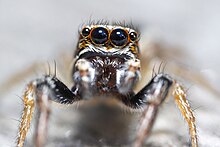| Icius pulchellus | |
|---|---|

| |
| A spider of the Icius genus | |
| Scientific classification | |
| Domain: | Eukaryota |
| Kingdom: | Animalia |
| Phylum: | Arthropoda |
| Subphylum: | Chelicerata |
| Class: | Arachnida |
| Order: | Araneae |
| Infraorder: | Araneomorphae |
| Family: | Salticidae |
| Subfamily: | Salticinae |
| Genus: | Icius |
| Species: | I. pulchellus |
| Binomial name | |
| Icius pulchellus Haddad & Wesołowska, 2011 | |
Icius pulchellus is a species of jumping spider in the genus Icius that lives in South Africa. It was first described in 2011 by Charles Haddad and Wanda Wesołowska. Only the female has been described. The spider is small, with a carapace measuring between 2.0 and 2.5 mm (0.079 and 0.098 in) long and an abdomen that is between 2.0 and 2.4 mm (0.079 and 0.094 in) in length. It has a sickle-shaped embolus. The spider is similar to the related Icius minimus, but can be distinguished by the pattern of the abdomen, which includes a brown stripe down the middle, and its short fat tibial apophysis.
Taxonomy
Icius pulchellus is a jumping spider that was first described by Charles Haddad and Wanda Wesołowska in 2011. It was one of over 500 species identified by Wesołowska during her career. It was allocated to the genus Icius, raised by Eugène Simon in 1876. The genus name is based on two Greek words that can be translated distinct, or special, face. The species name derives from the Latin for fair, neat or pretty. The genus is a member of the tribe Chrysillini, within the subclade Saltafresia in the clade Salticoida. Chrysillines, which had previously been termed heliophanines, are monophyletic. In 2016, Jerzy Prószyński split the genus from the Chrysillines into a group called Iciines, named after the genus. He stated the split was for practical reasons as Chrysillines had become unwieldy.
Description
Icius pulchellus is a small spider. The male has a carapace that is between 2.0 and 2.5 mm (0.079 and 0.098 in) long and 1.5 and 2 mm (0.059 and 0.079 in) wide. It is oval, medium height and dark brown with a streak formed of white hairs down the middle and two more along the sides. The eye field is black with reddish-fawn hairs. The abdomen is similar in size, between 2.0 and 2.4 mm (0.079 and 0.094 in) long and between 1.4 and 1.8 mm (0.055 and 0.071 in) wide. It is a dark brown oval with a brown stripe down the middle and the sides clothed in dense covering of light hairs, white, yellow and fawn. The underside is yellow. The chelicerae are large, dark brown and unidentate. The spinnerets are dark and the legs are yellow to light brown with brown and white hairs. The pedipalps are dark brown with white hairs on the top. The palpal bulb is an irregular shape with a sickle-shaped embolus and short fat tibial apophysis, or appendage attached to the tibia. The female has not been described.
The species is similar to others in the genus, particularly Icius minimus. The spider can be distinguished by the shape of the tibial apophysis and the pattern on the abdomen.
Distribution and habitat
Icius pulchellus is endemic to South Africa. The holotype was discovered in 2009 in the Sandveld Nature Reserve. Examples have been found in Free State and Northern Cape. The species thrives in grasslands.
References
Citations
- ^ World Spider Catalog (2017). "Icius pulchellus Wesolowska, 2011". World Spider Catalog. 18.0. Bern: Natural History Museum. Retrieved 13 July 2017.
- Wiśniewski 2020, p. 6.
- Haddad & Wesołowska 2011, p. 75.
- Fernández-Rubio 2013, p. 127.
- ^ Haddad & Wesołowska 2011, p. 76.
- ^ Maddison 2015, p. 278.
- Prószyński 2017, p. 25.
- Haddad & Wesołowska 2011, p. 77.
- ^ Haddad & Wesołowska 2011, p. 78.
- Wesołowska & Haddad 2018, p. 892.
Bibliography
- Fernández-Rubio, Fidel (2013). "La etimología de los nombres de las arañas (Araneae)" [The etymology of the names of spiders (Araneae)]. Revista ibérica de Aracnología (in Spanish) (22): 125–130. ISSN 1576-9518.
- Haddad, Charles R.; Wesołowska, Wanda (2011). "New species and new records of jumping spiders (Araneae: Salticidae) from central South Africa". African Invertebrates. 52 (1): 51–134. doi:10.5733/afin.052.0105. S2CID 86586010.
- Maddison, Wayne P. (2015). "A phylogenetic classification of jumping spiders (Araneae: Salticidae)". The Journal of Arachnology. 43 (3): 231–292. doi:10.1636/arac-43-03-231-292. S2CID 85680279.
- Prószyński, Jerzy (2017). "Pragmatic classification of the World's Salticidae (Araneae)". Ecologica Montenegrina. 12: 1–133. doi:10.37828/em.2017.12.1.
- Wesołowska, Wanda; Haddad, Charles R. (2018). "Further additions to the jumping spider fauna of South Africa (Araneae: Salticidae)". Annales Zoologici. 68 (4): 879–908. doi:10.3161/00034541ANZ2018.68.4.011. S2CID 86626109.
- Wiśniewski, Konrad (2020). "Over 40 years with jumping spiders: on the 70th birthday of Wanda Wesołowska". Zootaxa. 4899 (1): 5–14. doi:10.11646/zootaxa.4899.1.3. PMID 33756825. S2CID 232337200.
| Taxon identifiers | |
|---|---|
| Icius pulchellus | |